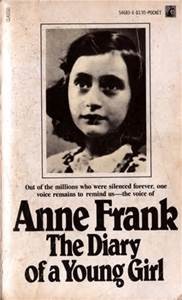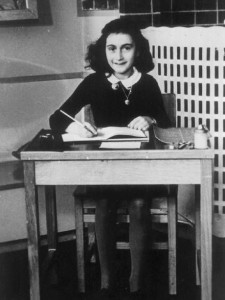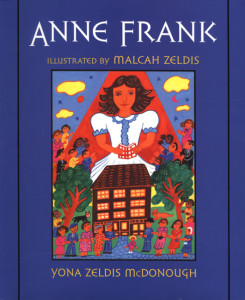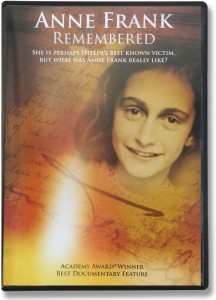Notes From the Lampert Library
 The young girl stares out at me from the cover of a yellowed, 25-cent paperback. Her dark eyes are intelligent and penetrating as if they know the secrets of the world. But they don’t. Her name is Anne Frank; the book is my copy of The Diary of a Young Girl, purchased with my own money from one of the Scholastic Book Clubs when I was in junior high school.
The young girl stares out at me from the cover of a yellowed, 25-cent paperback. Her dark eyes are intelligent and penetrating as if they know the secrets of the world. But they don’t. Her name is Anne Frank; the book is my copy of The Diary of a Young Girl, purchased with my own money from one of the Scholastic Book Clubs when I was in junior high school.
That was my first contact with the Holocaust. I am sure that Anne Frank’s diary was the first Holocaust experience for many young readers of my generation. The Holocaust was still fresh; survivors did not speak about their experiences. Anne’s diary was one of very, very few books that gave a (mostly unfiltered) first hand experience of the Holocaust that young readers could understand.
In fact, there were almost no primary sources in English for those who wished to understand. A few years later in college, I wrote a paper for a Modern European History course. Almost all the first hand sources were in Yiddish, Polish or German. It was not until years later that diaries and other primary sources were available in English.
Fortunately for readers, in 1952, an English edition of The Diary of A Young Girl was published. Shortly afterwards an inexpensive mass-market paperback made Anne’s words accessible to millions.
 Anne has become an icon representing the Holocaust experience. Although insightful, we must remember that Anne Frank’s experience was but one out of millions. However, because it was almost the first – and certainly the first to have commercial power behind it – it is revered. Eleanor Roosevelt wrote an introduction. It has has been translated into scores of languages, made into more than one movie, and dramatized several times. Its words have spawned biographies of Anne and others related to her written for every age level, inspired novels and short stories and been the subject of several lawsuits. The Diary, originally called The Secret Annex, is considered one of the most important books of the 20th century.
Anne has become an icon representing the Holocaust experience. Although insightful, we must remember that Anne Frank’s experience was but one out of millions. However, because it was almost the first – and certainly the first to have commercial power behind it – it is revered. Eleanor Roosevelt wrote an introduction. It has has been translated into scores of languages, made into more than one movie, and dramatized several times. Its words have spawned biographies of Anne and others related to her written for every age level, inspired novels and short stories and been the subject of several lawsuits. The Diary, originally called The Secret Annex, is considered one of the most important books of the 20th century.
Currently (October 14-November 21), Drew University’s Shakespeare Theater is presenting the most often done dramatization by Frances Goodrich and Albert Hackett, which won the 1956 Pulitzer Prize. Author Wendy Kesselman has adapted the play for more modern audiences, changing the order of the play and adding material not in the original edition of the Diary. (For a guide to the play, go to www.shakespearenj.org)
The play has garnered some negative comment. Since it is based on a version of the diary with some redacted by Anne’s father Otto, the lone survivor of the immediate family, critics say that Anne is not truly represented and that the play glosses over the family’s Jewishness and the realities behind that bookcase at the foot of the stairs.
However, one must consider that in 1955, World War II and the Holocaust had been over barely 10 years. The wounds were still fresh. The authors of the play look at Anne’s optimism, the strength that the family developed in hiding, and the generosity of sharing their space with others who needed a haven. It was in an attempt to appeal widely, some critics say, that the Jewishness of the family was played down.
If one reads later editions of the diary, Anne emerges as a young woman who is maturing both physically, emotionally and intellectually. She records everything around her including the tension between her parents. Anne wanted to be a writer-indeed, critics have seen real literary talent in the diary – so after hearing that first hand experience of the war would be collected when the war was over, Anne edited her diary for publication.
Thus there are two versions of some of the diary as well as pages that have been added to the original publication as they came to light.
It’s been seventy years since Anne’s death. In 2016,were Anne still alive, she would be celebrating her eighty-seventh birthday in a few months. We can only guess at what she would have become.
But what remains is an intimate portrait of a young girl growing up hoping that there would be a future and, if there were to be no future, hoping that her words would give her one.
Selected related titles available in the synagogue or public library
(J – young readers; YA – young adult readers)
 J – Abramson, Who was Anne Frank?
J – Abramson, Who was Anne Frank?
YA – Colbert, 10 Days
YA – Dogar, Annexed
Feldman, The Boy who Loved Anne Frank
Frank, Diary of Anne Frank: the critical edition
Frank, Diary of a Young Girl: definitive edition
Gies, Anne Frank Remembered
Linder, The Last Seven Months of Anne Frank
J – McDonough, Anne Frank
YA – Metselaar, Anne Frank: Her life in words and pictures
YA – Rubin, Searching for Anne Frank
J – Pressler, Anne Frank
J – Sasso, Anne Frank and the Remembering Tree
J – Sawyer, Anne Frank: A photographic story of a life
J – Tyler, Anne Frank: What made them great series
 There also several DVDs relating to Anne Frank:
There also several DVDs relating to Anne Frank:
Anne Frank Remembered
Dear Kitty
Diary of Anne Frank – Interviews with Anne’s cousin Buddy Elias
- Is It Passover Yet? - Thu, Apr 18, 2024
- MESH Report April 9, 2024 - Thu, Apr 11, 2024
- Guess Who? - Wed, Mar 13, 2024

